“So, what is it between man and mountain, esp. Mt. Everest?” Raj asked as he took another spoonful of the dal bhat (lentils and rice), which will soon become our staple diet. Doc was too engrossed in his dal bhat to rake up his cerebral matter to look for an answer. The two pair of eyes were now fixed on me, waiting for me to reply. One pair of eyes (mine) was still fixed on the Raj’s untouched fried papad. His pair of eyes relented as he indicated that I could have it. After all true wisdom doesn’t come for free. As I bit into the crispy papad, I started my discourse with a (profound) one-liner.
“Because, it’s there”.
The two pair of eyes froze. I could see respect (for me, I think) in those eyes.
“Wow, you are so right. Bang on!” Raj exclaimed.
Doc didn’t say much but he had stopped devouring his dal bhat.
I had their attention.
Both of them were in awe after hearing my one-liner reply, which well… ummmm…was …actually…..I…borrowed from someone.
Well, that someone was George Mallory, the legendary British mountaineer who had replied with the same one-liner, when asked, why he wanted to climb Mt. Everest.
I continued with the story about George Mallory and his successful (debatable), yet tragic attempt on the big mountain in 1924. My spiced up version.
There was silence as I finished narrating the story. We quietly went back to the Nepali spiced up version of dal bhat.
We, as in Raj (a CA in his mid-twenties), Doc (an Orthopaedic surgeon in his forties) and me (crunched between the two generations) had landed the same day in Kathmandu in our quest to trek to the Everest Base Camp (holy grail for many, esp. the summit). We would be trekking together, alongwith our guide, Santosh, from Kathmandu (1350 m/4430 ft.) to the Everest Base Camp (5344 m/17600 ft.) and back in the next twelve days.
The silence was now killing me, so I put forth another profound one.
“Mt. Everest arouses a powerful desire. To those who don’t feel it, it cannot be explained.”
More silence followed, this time with more respect and awe.
I was pleased with my performance. (I had borrowed this one from Jon Krakauer’s book “Into Thin Air”, about the tragedy on Everest in 1996)
Day 1&2: 9-10 Apr 2011: Thamel, Kathmandu (1350m/4430 ft.)
It all started few days ago, as I checked into the Terminal 3 in Delhi. I was dumbstruck by this awesomely posh airport.
India shining?? I thought for a moment. Not exactly, when an old Gandhian was starving, fighting corruption in a different part of the city.
However, the entire country was still reeling with the euphoric Cricket World Cup Win. Everybody around me was talking about the exploits of their cricketing heroes Sachin, Dhoni, Yuvraj et al. This will go on for many days and maybe for many years, considering the fact that the previous euphoria slugged on for 28 long years.
And here I was, thinking about another set of heroes, very few in this country knew or even cared about. Great mountaineers and climbers like George Mallory, Maurice Herzog, Hillary, Norgay, Reinhold Messner, Apa Sherpa and our very own Bachendri Pal.
Was something wrong with me?
At the Kathmandu airport, I saw a sea of trekkers, climbers and mountaineers from different part of the world. I saw the large and heavy expedition bags and could visualize their content – climbing gear, snow boots, crampons, harnesses, ropes, oxygen cylinders and more.
I could smell adventure.
In a moment, I smelled confusion.
Huge queues had formed for Visa at the immigration. After half an hour of further confusion, I figured out that Indians need not stand in those queues and I quietly slipped away from a different “queueless” counter.
As I came out of the airport I saw Raj, Doc and Santosh, who had been waiting for more than two hours. They “welcomed” me. We squeezed ourselves into Maruti 800 cab with our luggage (Most of the cabs in the city are old Maruti 800s). After an uncomfortably intimate journey we reached our hotel in Thamel.
Thamel is a popular tourist destination lined with shops selling everything from yak wool shawls to all the adventure gear, clothes etc. The atmosphere was hippiish and intoxicating. I felt that I was in Anjuna Beach, Goa with crowds of adventure tourists, loud music and live bands playing reggae to rock.
We met Gopi who together with the team that co-founded Rustik Travel, a sustainable experiential travel company had planned this trek. We handed him wads of 100 Rupees notes and felt much lighter. (500 and 1000 denominations of Indian Currency are banned in Nepal). Indian currency is accepted everywhere in Nepal (1 Indian Rupee = 1.6 Nepali Rupee). Felt good to be in a place where INR was valued higher.
The next day we roamed around the streets of Kathmandu (nothing much to write about) and visited Swayambhunath.
I tried hard to sleep that night. Not because we had an early morning flight. Not because it was cold. No not because of the cacophony from the street incl. the live band performing U2 numbers in the pub next door (clip here).
Because I was in a big big dilemma.
Should I take a bath in the morning or not?
Day 3: 11 Apr 2011: Kathmandu – Lukla (2866m/9403 ft.) – Phakding (2650 m/9248 ft.)
I did take a bath in the morning. A wise decision as I would find in days to come, as we went “bathless” during the trek.
At Kathmandu airport, we waited for four loooong hours as our flight was delayed. (Trekkers should keep buffer days in their itinerary as Kathmandu-Lukla sector is notorious for flight delays and cancellations due to bad weather).
Four hours passed with excruciating slowness as Doc who had researched well, “enlightened” us about the accidents which took place at the Lukla airstrip. He even showed us the videos from his phone.
And when the plane (actually a sixteen seater, with a stewardess whose only job was to hand over candies and cotton plugs) landed in Lukla with a big THUD, I thought that was it.
But, we lived to see another day.
We met our porters Gokarna and Pravin, young lads, both of them, still studying and doing this work in their vacations.
As we started walking I could see trekkers everywhere. There were even “traffic jams” at certain bottlenecked trail paths. This was a bloody highway. One of the most popular trek routes in the world. I realized.
Now the “real” brands – The North Face, Mammut, Marmot, Black Diamond and the likes stared at my Puma, Reebok, Adidas. I felt so much out of place. I hoped my Quechua backpack and bottle would help salvage some pride.
We walked breezily to Phakding as we passed through many villages, chortens, fields. Beautiful.
It took us just three hours. Piece of cake !! Haah !!
We settled into the lodge. The EBC trek is lined with similar lodges at all stops. With menu, facilities to die for. Luxury!! Commercialization!!
Couldn’t help comparing with the treks in the Indian himalayas where one has to really slum it out.
Day 4: 12 Apr 2011: Phakding – Namche Bazaar (3500m/11480 ft.)
As we left Phakding, “What the phak” and similar wisecracks emerged as we ridiculed the easiness of the trek based on yesterday’s “stroll”.
The initial trail from Phakding was marked with ups and downs with criss-crossing bridges over the Dudh Kosi river. We could see the magnificent snow capped peaks of Thamserku and Kusum Kangru.
We entered the Sagarmatha National park (we had to show our passports here).
Soon our exclamations changed from WTP to WTF as the steep climb to Namche after lunch at Jorsalle, took its toll.
Day 5: 13 Apr 2011: Namche Bazaar – One day of acclimatization
Having climbed almost 700 m the previous day, we planned one day of rest and acclimatization at Namche. Typically all trekkers do.
We were reminded of the popular phrase almost on every trekker’s lips and on T-shirts hung on the ceiling of many a Tea houses – “slowly, slowly catch a monkey“, which meant be cautious and patient. Do not climb too high too fast.
Namche Bazaar is a large village, marked with shops catering to the trekkers and climbers. It is a social and commercial hub of the Sherpas. High speed cybercafes, bakeries, pool parlours and pubs are a commonplace here. Namche is very well developed, with the per capita income higher than that of Kathmandu. Has its own uninterrupted power supply from a hydroelectric plant nearby. The village is very clean as it has its own efficient garbage disposal system with incinerators etc.
For our acclimatization, we walked up to the Sagarmatha National Park headquarters and museum. We could see the magnificent peaks – Ama Dablam and Lhotse (4th highest mountain peak in the world) . Everest was however hidden behind the clouds.
Now my scalp was itching big time. I couldn’t wash or shampoo in this biting cold. I should’ve had cut my long locks. I told myself.
And then one of the cooks (a young lad trying to grow his hair) in the lodge remarked, “Aap ke baal bahut achhe hain”. Let me repeat that in English, “your long hair is very cool.”
My face beamed. The itching stopped. I gave him some tips.
In the dining hall, we saw a couple of folks who had to come down because of altitude sickness.
Immediately, I drank an entire bottle of water and two bowls of dal from the still delicious yet repetitive dal bhat with chicken. I tried to justify:
1/ Water is expensive as we climb up. We decided to buy boiled water (still expensive).
2/ Drinking lots of fluid helps avoid altitude sickness.
Day 6: 14 Apr 2011: Namche Bazaar to Tengboche (3867 m/ 12687 ft.)
It was supposed to be a 5 hour trek.
The first three hours was downhill through a quaint village of Kyanjuma where we stopped for ginger tea.
According to Doc, ginger is an anti-oxidant and good for joints. I chewed the ginger hard.
We went further downhill to the bottom of Dudh Kosi and stopped for lunch at Phunki Thanga.
Post lunch we crossed a long suspension bridge on the river and from thereon the climb started.
After 1.5 hours of laborious climbing I reached Tengboche. The rest arrived an hour later.
I was happy with my great (ahem!!) fitness levels. Two months of “gymming”, working on cardio, quadriceps/hamstrings had helped. I felt good.
However, the guide didn’t share the same emotion. He told me to take it easy and not to walk too fast.
I was again reminded of “slowly, slowly catch a monkey” phrase. We saw more trekkers who had turned back due to AMS (Acute Mountain Sickness).
The small hamlet of Tengboche is known for its monastery, the largest in the Khumbu region. We attended the prayers. As we came out, we were welcomed by the snowflakes. It was effing cold as we felt the wind chill. But it was beautiful. After our daily dose of dal bhat (now it was really getting to me), we crashed for the night.
Day 7: 15 Apr 2011: Tengboche to Dingboche (4530 m/14800 ft.)
The lodge and the room at Tengboche sucked.
The room temperature in the night fell to 5 deg celsius.
I woke up early. The weather had cleared after previous night’s snowfall as the sun inched up. I got great shots of Nuptse and Lhotse.
We started walking comfortably downhill through the forest. The soft ground was a pleasure to walk on after days of rocky climbing and walking.
We stopped at Orshyo for lunch and took another two hours to reach Dingboche.
The wind chill had ensured that we were almost frozen, so we parked ourselves next to the heater in the lodge and played cards. Doc, a Las Vegas veteran won, of course.
Santosh entertained us with his version of “Sheila ki jawani”.
Day 8: 16 Apr 2011: Dingboche – One day of acclimatization
Dingboche is a small village with a handful of lodges and huts. It is characterized with agricultural land (potatoes and other veggies) and a helipad of HRA- Himalayan Rescue Association.
The helicopters buzzed regularly flying in AMS patients to lower heights. We had planned to stay here for a day to acclimatize.
We set out early in the morning for an acclimatization climb up a 200 m mountain. Magnificent Ama Dablam and Island peak were in view in all their glory.
We felt much better after that as the rest of the day we just lazed around in the sun and the dining hall. Chatted with other trekkers on their way to the base camp.
I had a room to myself. No bath for days was now getting to me. So, I bathed myself with deo. At least I smelled good.
I wondered how did Everest summiteers manage for days. But it seems that Base Camp tents have hot shower facilities. Man!! Talk about luxury at that altitude !!
I put out my layers of clothes (dry fits) to be aired as I packed for the next two days (the most challenging in this trek).
Day 9: 17 Apr 2011: Dingboche to Lobuche (4930 m/16163 ft.) through Dughla (4595 m/15,075 ft.)
We started at 7 a.m.. As we crossed the mountain we had climbed yesterday, we saw a huge stretch of plain land. We were encouraged.
However, I walked slowly remembering the “monkey” phrase.
We reached Dughla in 2 hours. Dughla is a village marked with 3-4 lodges.
After the quick stopover for noodle soup here we set out for a steep 1 hour climb. The top of this mountain had memorials of various Everest climbers like Scott Fischer (from the ’96 Everest disaster), Babu Chiri Sherpa (who hold 2 world records – fastest ascent and spending 21 hours without oxygen on the summit…..!!!!!!).
In two hours we reached Lobuche (the base of the magnificent Lobuche mountain) and quickly ordered multiple rounds of ginger tea, hot orange and hot lemon (great drinks in that freezing cold).
My head was now feeling heavy. Raj felt similar heaviness. Doc was fine.
I popped in dispirins (aspirins dilate blood vessels which eases the passage of oxygen/blood to the brain) and continued imbibing hot drinks (which have become even more expensive).
Post-lunch we headed out for a 100 m climb for acclimatization. Raj and I felt slightly better as we descended. As we came back, we heard shouts and saw smoke and a huge crowd from our lodge. There was a fire and the kitchen had burned down. Fortunately, the fire didn’t spread into the rooms. We saw our luggage along with everybody else’s out in the freezing cold. It was getting dark, all the trekkers were extremely cold and worried about where to sleep in the night as all the other lodges were full.
The guides and porters came together and made a temporary arrangement in a hut, while restoring the kitchen in the lodge. In a couple of hours everything was back to normal. I am amazed at the efficiency and the hardwork.
Later in the night I checked the temperature, it was close to zero degrees celsius, definitely minus 5-10 outside as it was snowing.
I slept for only 2-3 hours after popping more dispirins, painkillers and cetrizine for continuously running nose and cold.
Tomorrow was the D-Day. The Base Camp day. I was already exhausted, itchy and uncomfortable.
Day 10: 18 April 2011: Lobuche to Gorakshep (5180 m/17,000 ft.) to Everest Base Camp (5364m/17,600 ft.)
I knew that today was going to be a long day. We started at 7 a.m with a quick breakfast.
We started walking slowly uphill. Midway I checked my altimeter. It read 5,000 m. Difficulty in breathing increased as now mentally I am aware of this height. I trudged along slowly.
We reached Gorakshep in 3 hours. Gorakshep was the first base camp set up during Hillary-Norgay expedition.
Gorakshep had now transformed into a small hamlet of lodges (with sat phones and internet access) catering to trekkers and summiteers (many of them) from the base camp.
Our lodge was run by an ex-summiteer and an Everest Marathon participant. I bonded with him esp. on the marathon bit. He pointed out to many summiteers and would-be summiteers in the dining hall. I was so charged.
After a quick brunch with enough carbs and proteins as Doc had recommended, we were on our way to the base camp.
However, midway, Doc turned back complaining of dizziness and headache.
We continued trudging along with many trekkers whose numbers just kept on increasing.
I spotted a group of young mountaineers in their brand new bright coloured Gore-Tex. I caught up with them. They represented the Nepal Mountaineering Association and were summiting in May. They were led by a young, athletic guy named Karma Sherpa. I chatted up with him for a bit. He had already summited the peak three times. I was now in complete awe.
I overtook them.
We walked on the narrow trail uphill, giving way to yaks and porters, who passed us by on regular intervals. Tonnes of expeditions’ luggage was being transported to the Base Camp.
On the right was the famous Khumbu glacier. It was covered with rock and sand, but one couldn’t miss the blue ice peering from beneath at various points. It was massive.
Finally, we walked over the glacier and climbed up to reach the “Everest Base Camp point” from where the “real” base camp was visible.
Only the summiteers were allowed to go beyond this point. The base camp was crowded with brightly coloured tents pitched right on top of Khumbu Glacier just below the dangerous Khumbu icefall.
The EBC point was now crowded with the euphoric and hysterical trekkers posing against the stone tablet engraved “Everest Base Camp 5364”.
I took photos all around and posed with the stone tablet. In the process, managed to drop the tablet. Everyone now looked at me with anger. Fortunately it was not broken.
I placed it back and quickly disappeared from the scene.
We started our journey back to Gorakshep. And then it started to snow heavily. There was a huge traffic jam of trekkers in front of us. Many of them were still coming towards the base camp. (I was reminded of the infamous traffic jams on Hillary step at 28840 ft. while summiting Everest. The delay here had caused many casualties in the past).
The snowing intensified.
And then, Santosh went off the path bypassing the trekkers. It was tricky, but I followed him. However, on the way back we encountered more such jams. Man!!
Back in the lodge, we were jubilant however were too tired and cold to even attempt a celebration.
Also, Doc was unwell. He felt suffocated. He took Dimox (a medicine recommended for AMS, however has its side effects).
We decided to start for Kalapathar (5,545 m) the next morning at 3:30 am.
Day 11: 19 April 2011: Gorakshep to Kalapathar (5545 m/ 18,187 ft.) and back to Orshyo via Dughla
Kalapathar is a mountain just below the south face of Pumori (7161m/23,494 ft.). Mt. Everest can be viewed clearly on top of Kalapathar.
Santosh knocked at the door at 3 a.m. I wished he hadn’t. I was wide awake, couldn’t sleep the entire night. (high altitude and cold had gotten me)
It was the D-Day. But I had no bloody idea which day it was.
I have been looking forward to this day for many years now, and now cold, breathless and sleepless, I just wanted to get it over with.
“Respect the mountains” as the Sherpas say. You never know what altitude can do to you.
I finally got up unwillingly and pulled myself out of the sleeping bag. After much dilly dallying we left at 4 a.m. We checked on the Doc. He was feeling better, but had sensibly opted out of the Kalapathar climb.
Armed with chocolate bars, water and our headlamps we set out in the moonlit night. The temperature was sub-zero.
With the help of our hiking poles we started climbing the unending STEEP (at least 75 degree) incline.
We took frequent rest breaks as we slowly trudged alone.
I kept my eye on the altimeter.
We estimated that it would take at least three hours to reach the top. After one hour or so, we were joined by a few trekkers who had started after we did.
As the day broke, we could see the top of Kalapathar (marked by a flagpole and Buddhist prayer flags). And there it was the elusively shy Mt. Everest behind us. A mammoth of a peak, emerging behind an equally magnificent Lhotse.
It stood majestically overpowering other peaks in the vicinity, reminding everyone, “dude, I am the tallest in the world. Don’t mess with me”.
I reached the top in 2 hours flat. It was extremely windy.
I unleashed my SLR.
Raj joined me half an hour later. After the usual photo ritual we started to descend. I ran my way down and in an hour was back in the lodge.
Mission accomplished !! However, the feeling hadn’t sunk in !!
Now the long trek back. Phew !!
After breakfast, we walked for more than eight frikking hours (two of which was in a heavy heavy snowstorm after Dughla) to reach Orshyo.
Doc felt better now that we were in a lower (oxygen abundant) altitude.
We were too exhausted to celebrate.
Day 12: 20 April 2011: Orshyo to Namche
Another day of laborious walking for more than eight hours to reach Namche. We were happy to be here. The lodge, facilities and food was good.
In the dining hall I met Shailendra Kumar Upadhyay, an 81 year old, who was on his way to summit Mt. Everest in May. It would be a world record if he succeeds. He had summited Mera peak (6476 m) a month ago without oxygen.
All of us were dumbstruck and were in awe.
Talk about human spirit, will power, resolute and all that. We could see all that in him. Later I googled and found out that he was a freedom fighter who had moved to Nepal and had served as the Foreign Minister in the past. (Incidentally, he died during acclimatization while descending from Camp I. However, he died doing what he liked the best. Kudos to him for his courage.)
Day 13: 21 April 2011: Namche to Lukla
Yet another day of laborious trekking which intensified as we approach Lukla.
Finito !!
We celebrated. Yak steaks, Everest beer (you can’t get “higher” than this)…..
Next day we flew to Kathmandu and then to Delhi, the day after.
As I curled myself in the uncomfortable plane seat, I couldn’t help but think about the first time I saw the majestic Kanchenjunga.
I was a mere 10 year old, visiting Sikkim on a family trip. And it was then I fell in love with the mountains, the Himalayas.
The EBC trek was just another journey in my quest to explore the Himalayas.
Deep in my mind I knew that this trek was just a recce.
And I will be back.
Till then…slowly, slowly catch a monkey.
![]() Download the ebook- Everest Base Camp Trek: a sneak “peak”
Download the ebook- Everest Base Camp Trek: a sneak “peak”
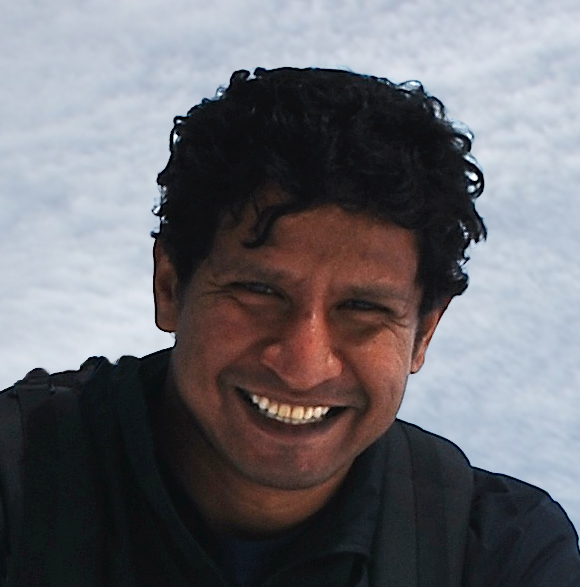
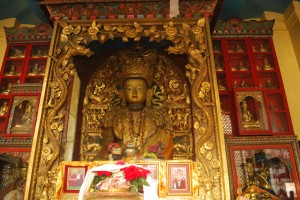

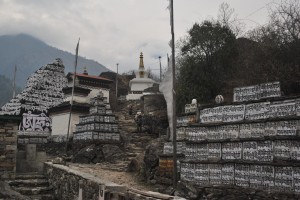
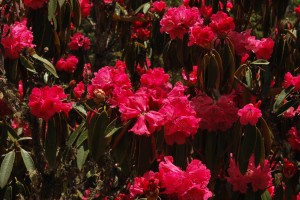

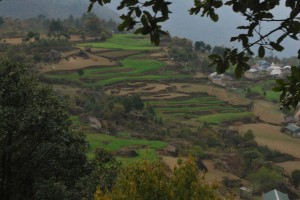
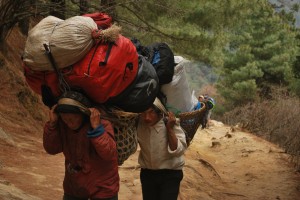
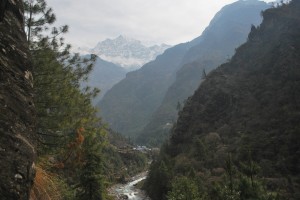
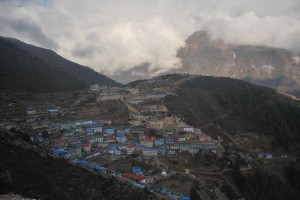
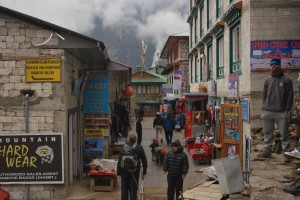


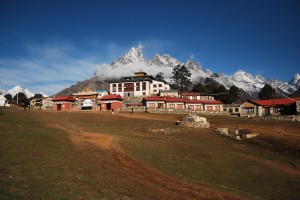
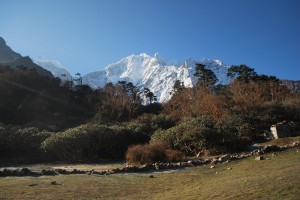
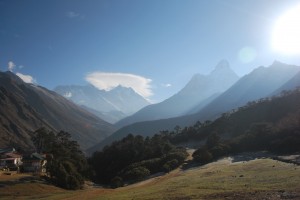
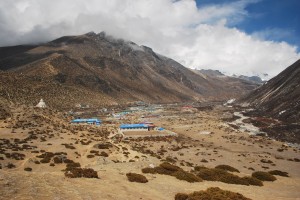

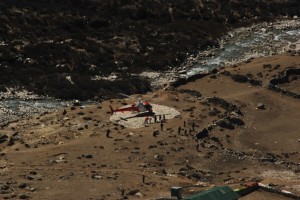
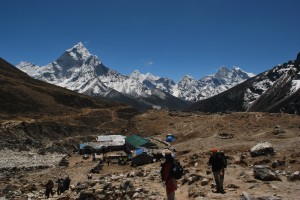

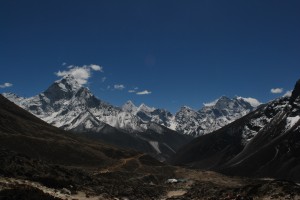

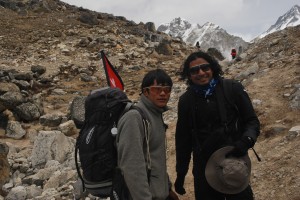
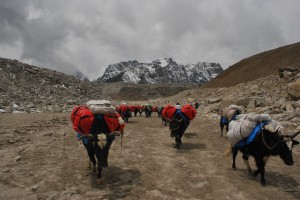



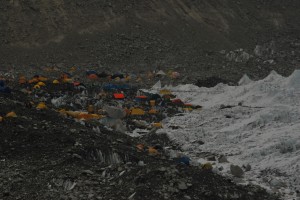
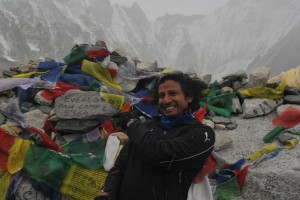
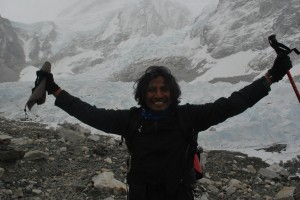
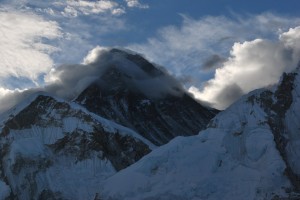
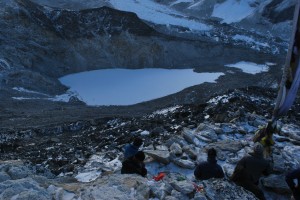
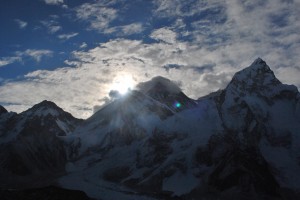

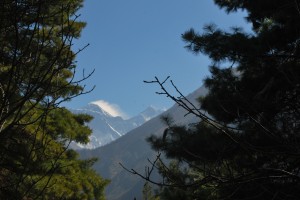
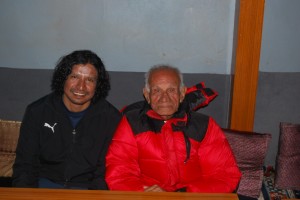
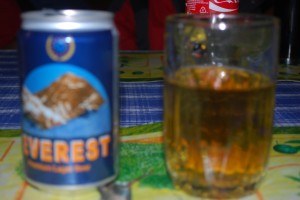
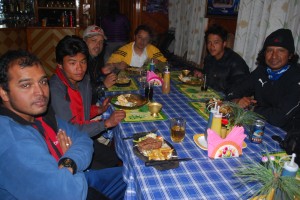
 Follow
Follow
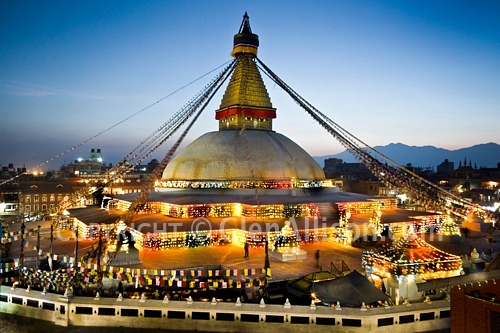










venky
puppy,
how much did the total expedition cost starting from Dilli?
Romit
Hemant, many congratulations – very well written and overall inspiring stuff!
Hemant Soreng
Thanks Romit…it was awesome….you should try it someday…
Priya
Hemant..if I am so excited reading and hearing about your life..I can only imagine your joy in living it! May I brag a little more of our friendship than is warranted? Thats the closest some of us could get to be inspiring! Congratulations..and all the best..for I am sure there are many more ‘summits’ to come!
Congratulations..and all the best..for I am sure there are many more ‘summits’ to come!
Hemant Soreng
Thank you Priya. I am definitely looking forward to some higher summits in the near future.
Rajkumar
Good piece Mr. Goldmedalist….
Hemant Soreng
Phillip
great article like the pictures alot
Nepal Trekking
Really great blog on your Nepal Experience
Destination Unlimited Treks
really nice blog for trekking in Nepal
Everest Base Camp Trek
Really Nice blog. A trek to Everest Base Camp is one of the most amazing adventures in the world and has become a Mecca for adventure travel enthusiasts. Just imagine standing at the point where so many expeditions have left on their way to the summit of the highest mountain in the world. The trek ventures deep into the Himalayas with amazing views of many of the world’s highest and most beautiful mountains.
Simran gupta
Very well written ….thanks for sharing
Hemant Soreng
Thanks Simran!!
Atilio
Great blog! Really iripsning. I’m hoping to head for EBC around june-july 2012, but I’ve heard so many bad things about that particular time of the year.Would you advise me to go anyway?
Hemant Soreng
June-July is not a good time to go because of the monsoon season…the rains will hamper flights to Lukla and also the trekking would be dangerous at the time…if you are planning to go then April – mid May is the best time…
Baidik
Very well written piece Hemant! I slowed up my reading towards the end; did not want my visualization to end
Wish you many more treks.
Baidik.
Hemant Soreng
Thank you Baidik.
Niranjan
Awesome and inspiring!!
http://www.rajniranjandas.blogspot.com
Hemant Soreng
Thanks Niranjan
Ashok Niroula
Excellent blog about Everest Base Camp Trek.
welcome to Nepal
Everest Base Camp Trek
Bhaswati
Great Blog Hemant! Wishing you many more summits in the future!
Hemant Soreng
Thank you Bhaswati!!
Simrik
Highly informative post. Keep on posting such a informative post. I would really like to do Everest Base Camp Trekking In Nepal before I die.
harish shetty
Good really nice , one thing we need not forget that sherpas
and the porters who carry our luggage are the real heroes .
Salute to them cause at that height they are our saviors .
Climbers who reach the summit always talk of themselves
but they need to know the guide & porters are the guys
who make the way for us .
Hemant Soreng
You are absolutely right. Without the sherpas nothing is possible out there in that altitude.
Blogspider
Your article is really amazing and also interesting. I am always excited to read article such as exclusively fantastic about trekking in Nepal. Thanks for such a great article about Trekking. Really interesting about Trekking In Nepal, it is always a pleasant surprise every time a position is both beneficial and enjoyable! Thanks for your information. Great work done by author. I appreciate it, Thanks for sharing this informative post. Keep posting updates.
Hemant Soreng
Thanks
jessy
Thanks for a nice share you have given to us with such an large collection of information of Everest Base Camp Trek. Great work you have done by sharing them to all. Simply superb.
pankaj shrestha
really interesting article with images thanks for sharing
Andrew
Thank you so much.
K K Rawat
hi .. can u plz let me know the approximate cost of the trek in INR, starting from Delhi
Hemant Soreng
when I went there last year it was around 32 k (excluding travel costs, porters etc.)….it is usually more depending on the co. you are going through
O.Tirkey
Bahut sundar likle. Hamin Goechala jai rahi. Ab tohar EBC pad ke hamin ke jayek laga they.
Kolkata